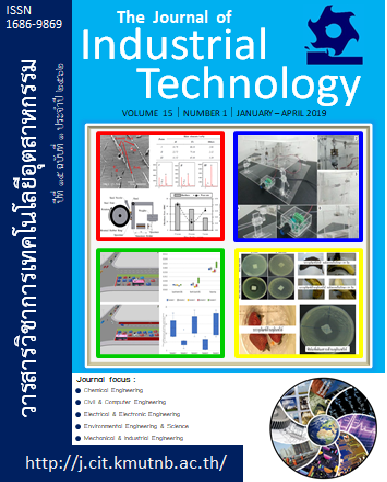(อิทธิพลขนาดคละของมวลรวมที่ส่งผลต่อกำลังรับแรงอัดและการชะละลายโลหะหนักของคอนกรีตมวลเบาผสมเศษของเสียเมลามีน)(Influence of Aggregate Fineness Modulus on Compressive Strength and Heavy Metal Leaching of Lightweight Concrete Containing Recycled Melamine Waste)
Keywords:
Fineness modulus, Leaching, Heavy metal, Lightweight concrete, Melamine wasteAbstract
This research aimed to investigate influence of aggregate fineness modulus on mechanical properties of cellular lightweight concrete containing melamine waste as fine aggregate. Melamine waste was used to partially replace sand at the rate of 25% by weight. The mixed ratio of cement: aggregate: water was set at 1:1:0.5 by weight. Density of fresh concrete was controlled at 1,300 kg/m3. The concrete specimens were varied by fineness modulus (FM) of the waste at FM1.25, FM1.0, FM0.75 and FM0.5. Compressive strength, water absorption and leaching test of heavy metal were investigated. The result was found that the melamine waste mixing yielded higher compressive strength and water absorption compared to reference lightweight concrete. The FM0.75 specimen resulted the highest compressive strength. It was also found that water absorption was slightly decrease with increasing fineness modulus of the waste. The leaching of heavy metals were determined by following the Toxicity Characteristic Leaching Procedure (TCLP). It was found that the concentration of As, Cd, and Pb were not exceed the limitation specified by the U.S.EPA and Ministry of Industry Announcement No. 6 (1997)
References
[2] M. Batayneh, I. Marie and I. Asi, “Use of selected waste materials in concrete mixes”, Waste management 27, 2007, pp. 1870-1876.
[3] P. Panyakapo and M. Panyakapo, “Reuse of thermosetting plastic waste for lightweight Concrete”, Waste Management 28, 2008, pp. 1581-1588.
[4] S. Siwadamrongpong and J. Aphirakmethawong, “Effects of Particle Size and Content of Waste Melamine Formaldehyde on Mechanical Properties of High Density Polyethylene Composites”, The 9th South East Asian Technical University Consortium (SEATUC) Symposium, Nakhon Ratchasima, Thailand, 2015.
[5] J. Phaiphulphim and G. Kaewkulchai, “Effects of Sand and Water Quantity to Stress-Strain of Cellular Lightweight Concrete”, UBU Engineering Journal 8, 2015, pp. 26-35.
[6] K. Jitchaiyaphum, T. Sinsiri, and P. Chindaprasir, “Cellular lightweight concrete containing pozzolan materials”, Procedia Engineering 14, 2011, pp. 1157-1164.
[7] C. Chaitongrat and S. Siwadamrongpong, “Recycling of melamine formaldehyde waste in lightweight concrete as aggregate replacement”, The 9th South East Asian Technical University Consortium (SEATUC) Symposium, Nakhon Ratchasima, Thailand, 2015.
[8] S. Srichaiyo, C. Chaitongrat and S. Siwadamrongpong, “Mechanical Properties of Lightweight Concrete Containing Melamine Formaldehyde Waste Using Full Factorial Design”, Journal of the Japan Institute of Metals and Materials 59, 2018, pp. 1216-1219.
[9] Nursyamsi and W. S. B. Zebua, “The Influence of Pet Plastic Waste Gradations as Coarse Aggregate towards Compressive Strength of Light Concrete”. Procedia Engineering 171, 2017, pp. 614-619.
[10] C. Chaitongrat and S. Siwadamrongpong, “Recycling of melamine formaldehyde waste as fine aggregate in lightweight concrete”, Songklanakarin Journal of Science and Technology 40, 2018, pp. 39-45.
[11] Z. Madiha and J. Ammari, “Grading of fine [14] W. Nanthamontry, “Study of the solidification process of synthetic metal hydroxide using cement mixed with condensed silica dust”, Master Thesis, School of Energy and Materials, King Mongkut's University of Technology Thonburi, Thailand, 2000.
[15] S. Asavapisit, P. Atipakya and P. Chaiprasert, “Solidification of Heavy Metal Sludge Using Portland cement and Steel Foundary Dust”, KKU Engineering Journal 28, 2001, pp. 35-48.
crushed stone and its effect on concrete properties used in the United Arab Emirates”. International Journal of Civil Engineering and Technology (IJCIET) 8, 2017, pp. 259-267.
[12] S. Srichaiyo, C. Chaitongrat and S. Siwadamrongpong, “Utilization of Melamine Formaldehyde Waste as Fine Aggregate in Lightweight Concrete”. Journal of Engineering, RMUTT 15, 2017, pp. 19-28. (in Thai
[14] W. Nanthamontry, “Study of the solidification process of synthetic metal hydroxide using cement mixed with condensed silica dust”, Master Thesis, School of Energy and Materials,
[14] W. Nanthamontry, “Study of the solidification process of synthetic metal hydroxide using cement mixed with condensed silica dust”, Master Thesis, School of Energy and Materials,
King Mongkut's University of Technology
Thonburi,Thailand, 2000.
[15] S. Asavapisit, P. Atipakya and P. Chaiprasert, “Solidification of Heavy Metal Sludge Using Portland cement and Steel Foundary Dust”, KKU Engineering Journal 28, 2001, pp. 35-48.


